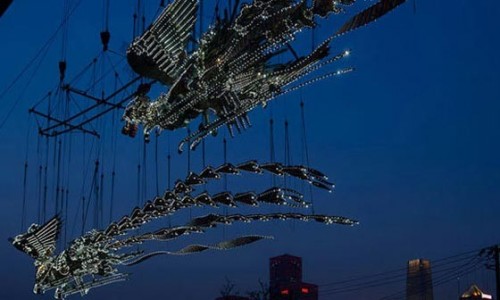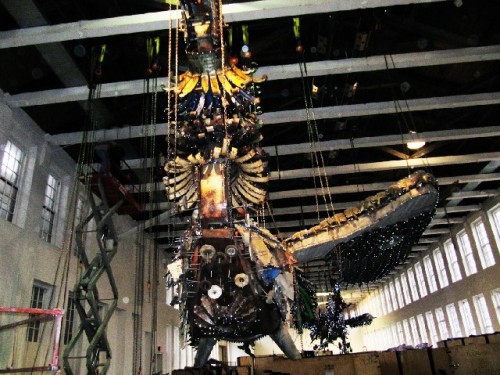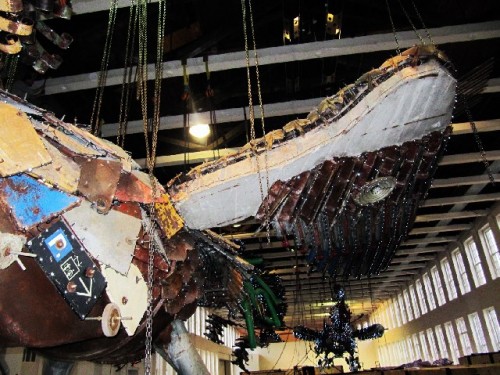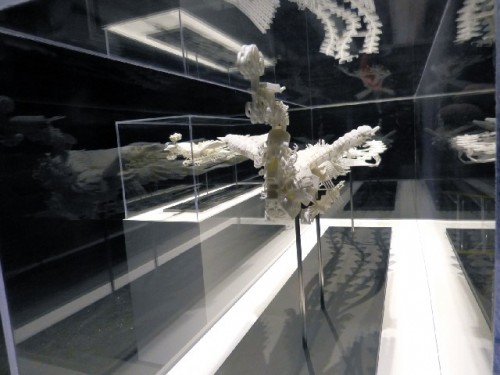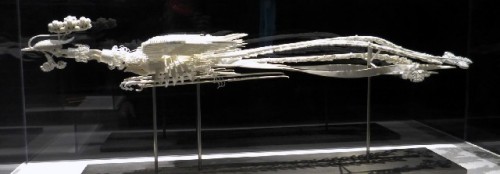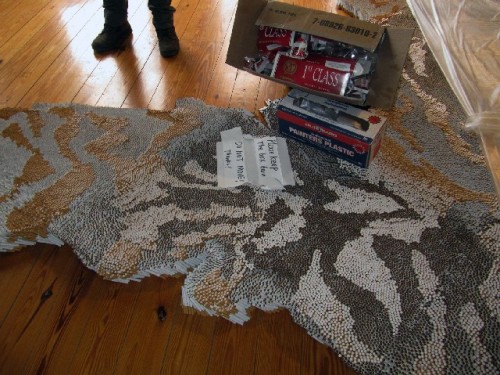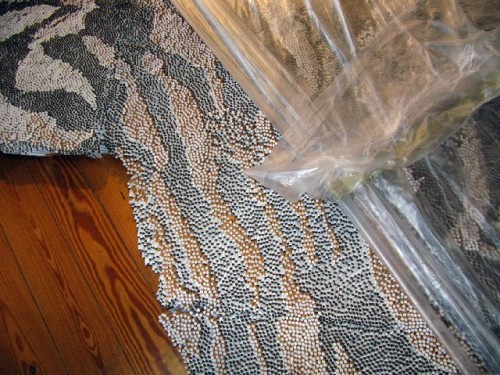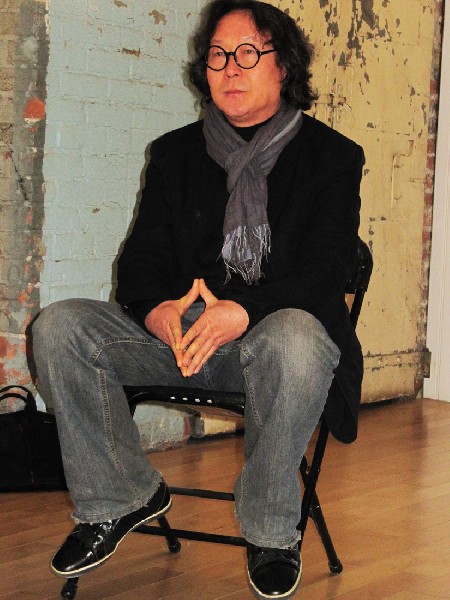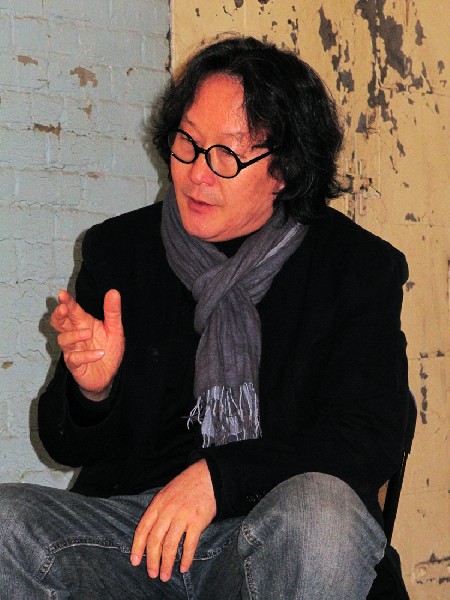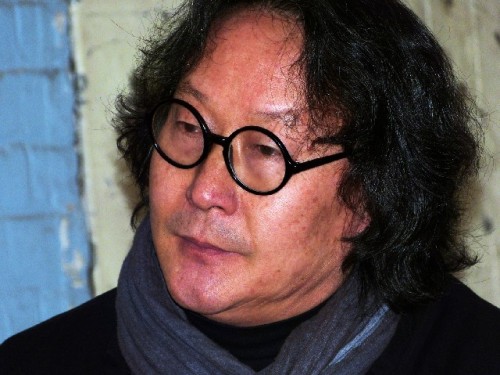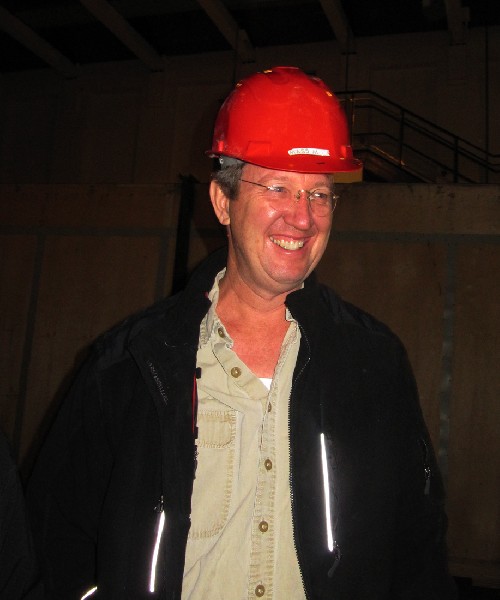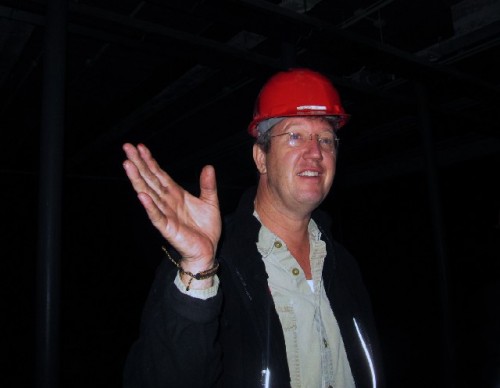Xu Bing Phoenix at Mass MoCA
Mythical Birds Evoke Contemporary Issues
By: Charles Giuliano - Dec 26, 2012
In 1995 the gallery of the Massachusetts College of Art presented Language Lost a deconstruction of text and communication by Xu Bing. Seventeen years later Phoenix, two, enormous, junk metal birds, are suspended in the vast space of Building Five of Mass MoCA. They will remain on view for the coming year.
Other elements of the exhibition include 1st Class, a faux tiger skin made of 500,000 cigarettes, and Background Story, a lightbox designed to look like a traditional scroll painting, but created from shadows cast by debris.
Xu (pronounced Shoo) Bing was born in Chongqing, Sichuan province, China, in 1955 and raised in Beijing. He studied Printmaking at the Central Academy of Fine Arts in Beijing, where he received an MFA in 1987. He subsequently taught at the Central Academy and is now its director. In 1990 he moved to the United States with a studio in Brooklyn, New York.
The Macarthur Foundation awarded him a five-year grant in recognition of "originality, creativity, self-direction, and capacity to contribute importantly to society, particularly in printmaking and calligraphy".
Now, almost a score of years later, we have come to know more about contemporary Chinese art. Mass MoCA has made a significant commitment to presenting its complex and insightful developments.
The museum presented House of Oracles: A Huang Yong Ping Retrospective in 2006 followed by Cai Guo-Qiang: I Want to Believe in 2008. The neighboring Williams College Museum of Art, in 2009, exhibited Liu Zheng: The Chinese a significant acquisition of photographs for its collection. The Hirshorn Museum and Sculpture Garden, in Washington, D.C., through the end of February, is presenting a retrospective of the dissident artist Ai Weiwei.
Of these artists the most overtly political and controversial is Ai Weiwei. As part of the 2012 Berkshire International Film Festival there was a compelling documentary film about his running conflicts with the Chinese government. The communist regime has jailed him, demanded millions in back taxes, and revoked his passport. Recently, we reviewed an exhibition of his work at Mary Boone Gallery in New York.
During a press conference with Xu Bing, and a tour of the exhibition then being installed, I asked him about the political implications of Phoenix and its references to the projects of Ai Weiwei.
He explained the specifics and complications of Phoenix, as conveyed through an interpreter. The dialogue, while poetic and charming, was also cautious and evasive of direct criticism of the regime. Significantly, after living in the United States for many years, he returned to Beijing where he works and teaches.
Avoiding any comments about Ai Weiwei and his struggles, somewhat cryptically, he stated that the work on view at Mass MoCA would not be possible had he remained in the West. "If I had stayed in New York and I spent my days in Soho or Chelsea to go to gallery shows, I would have never made a work like this."
During a press conference that preceded the meeting with Xu Bing, Mass MoCA director revealed that, as a young man, he and his parents were targeted by the Cultural Revolution of Chairman Mao.
Intellectuals, businessmen, doctors, lawyers, musicians, actors, artists and scholars, were relocated from urban to rural regions. They were forced to undertake the manual labor of farmers and peasants. The Cultural Revolution reeducated them regarding a proletariat or people’s revolution. There was a prevailing agenda of agrarian reform and affirmation of the peasant as the locus of political power.
Over the past twenty years there has been a complete reversal of those agendas. When we visited Shanghai a decade ago there was little evidence of Mao and the treacherous Gang of Four that followed.
While I had anticipated seeing workers in Mao suits we encountered one of the fastest growing cities in the world. Touring the busy downtown shopping area was like visiting an American mall with all of its familiar brand names.
There were vast fleets of bicycles in the streets and glimpses of the remnants of old neighborhoods. These have largely disappeared since then with ever more highrise buildings. Bicycles have given way to polluting cars and motorcycles.
Recent visitors to Beijing comment on severe air pollution. In Shanghai we experienced the stench of burning garbage and primitive sanitation. This has been exacerbated by a sharp increase in the use of fossil fuels.
In this process of urbanization, as Bing commented, the farmers and peasants have flocked to the cities as a part of an industrial and economic boom. This has entailed a shift from their powerful status under Mao to comprising today’s underclass of urban poor.
Leading up to the 2008 Beijing Olympics Bing was commissioned to create an installation in a large space at the top of a new industrial building. Visiting the site it evoked the feeling of a bird cage. As he told us, at first, he pursued the idea of creating a gigantic crane. This evolved into developing a pair of male and female phoenix birds.
The phoenix has many connotations in different cultures. The phoenix, fenghuang in Chinese, symbolized the male and female genders. In China it is two birds; feng male, and huang female. Later the phoenix was associated with dragons. For the Chinese "good fortune comes with the dragon and feng."
It has imperial aspects while in the West it signifies renewal. Having lost its feathers in a fire all of the other species of birds donated one feather each. Hence its variety and brilliance as well as rebirth rising from the ashes.
In traditional Chinese art the phoenix is represented two-dimensionally and in low relief. There are no in the round versions. So this was a challenge for the artist in developing maquettes. Two are on display at the museum.
While researching the project the artist formed close ties with the workers who would be fabricating the gigantic birds. Identifying with their circumstances he decided to create the birds using recycled materials from the many construction sites.
When constructing high rise buildings and industrial parks in America one of the daunting issues entails acquiring rights to properties. This can result in complex court cases and pursuit of eminent domain involving suitable compensation and relocation.
In communist China there are no such impediments. Neighborhoods and communities are razed with callous disregard for uprooted people.
The materials of the Phoenix project are reflective of the debris resulting from the destruction and recreation of the urban environment. It also signifies the brutal impact on the poor and disenfranchised.
The subversive subtext of Phoenix alarmed those who commissioned the project. When support was withdrawn the artist had to rely on his own resources to complete Phoenix. It was shown for a few days and then again, for a week, in a remote location during a trade show in Shanghai.
This is the first time that the sculptures are being seen outside of China.
As Thompson explained, with ironic humor, getting them to North Adams has been a nightmare. He emphasized the literal meaning of “a slow boat from China.” Shipping took forever including lots of red tape getting them through customs.
Around the edges of Building Five is a shelf on which is displayed the individual pages of a book created to document the unique history of the project. In addition to the work itself there is a time line of significant events both in China as well as globally.
Visiting the space and contemplating the enormous birds hovering overhead evokes multi-valent responses. There is the exhilarating visual pleasure of these huge junk birds flying above as well as the fascinating process of examining its disparate and redolent elements.
On a platform overlooking the end of Building Five we encounter Background Story. His use of cigarettes and tobacco products, in this case a carpet of some 500,000 individual cigarettes, started with a project for Duke University in 2000.
The university was founded by heirs to the Duke tobacco fortune. When he visited the campus and officials of the tobacco conglomerate they pointed to the map and China as the world's foremost consumer of tobacco products. His work with the materials underscores that grim association.
As Thompson commented during a walk through of the exhibition tobacco has long been used for its ceremonial and social aspects. In Native American culture it was a way of sealing deals and peace agreements. Its use is both ritualistic as well as deadly. During the Colonial era its export to Europe and subsequent boom was an essential aspect of the economic development of Virginia and the Carolinas.
Immediately after the invention of the cigarette machine in 1881, James B. Duke (1865 - 1925) is reported to have leafed through a world atlas to survey the population of foreign countries. Noting a Chinese population of 430,000,00, he stated "That is where we are going to sell cigarettes." In 1890 the Dukes exported the first cigarettes. Sales to China increased to 1.23 billion cigarettes in 1902, then 12 billion by 1916, earning $10.75 million with a net profit of $3.75 million.
From 1915 through the 1920s, the United States exported more cigarettes to China than to the rest of the world combined. British American Tobacco Company (or BAT, a multi-national company formed in 1902 with the Duke's chief competitors in England) would sell 80 billion cigarettes in China in 1928 alone and amass a total profit of over $380 million between 1902 - 1948. Today, China is the major market for American tobacco.
The experience of this exhibition resonates on many levels from the contemplation of amazing objects to processing their social and political implications.
With contemporary Chinese art there is a duality between macro, the immensity of scale, and micro through riveting attention to details.
Mass MoCA triumphs by taking on yet another seemingly impossible task. The end result is stridently powerful and intimately involving.
Yin and yang.

